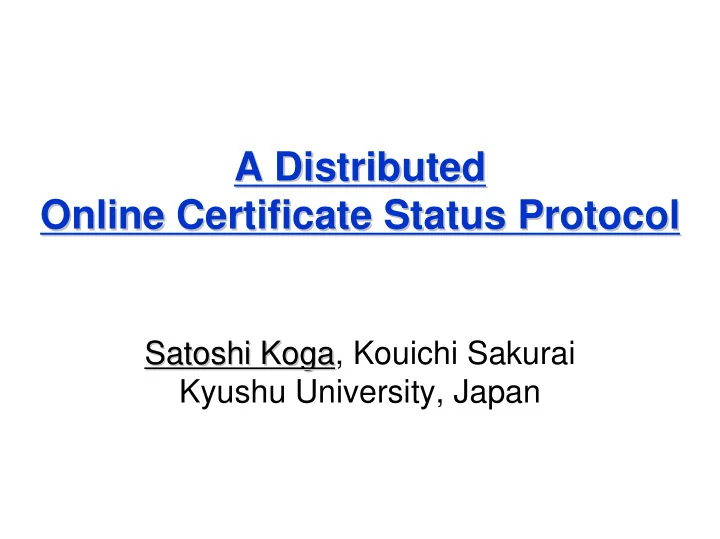

A Distributed A Distributed Online Certificate Status Protocol Online Certificate Status Protocol Satoshi Koga, Kouichi Sakurai Satoshi Koga Kyushu University, Japan
Background Background • Certificate Revocation Problem Certificate Revocation Problem • – The certificate should be revoked in case that: • User’s private key is compromised • User’s personal information is changed – The user should check whether the certificate has been revoked or not • Online Certificate Status Protocol (OCSP)
OCSP OCSP � The standard protocol of online revocation system 1. The client requests to OCSP responder • Is this certificate valid or not ? 2. The OCSP responder responses to the user • OCSP responder digitally signs the response Up-to-date user CRL response Certification Certification responder Authority(CA) ) responder Authority(CA request
Problems Problems – If responder is centralized If responder is centralized, it’s – vulnerable to Denial of Service (DoS) attacks –Compromise of responder’s private key is affected the entire system
Distributed OCSP Distributed OCSP • Private key exposures appear to be unavoidable – Minimizing the damage caused by responder’s key exposures is important • A D Distributed istributed OCSP OCSP (D (D- -OCSP) OCSP) composed of the multiple responders – Each responder has own private key – If the responder’s private key is compromised, the others are not affected
D- -OCSP OCSP D CA’s certificate CA CA responder’s certificate Client Client response + signature responder 1 responder 1 responder n responder n PK 1 SK , PK n SK , 1 n
Motivation Motivation • General D-OCSP – Every time the client receives the response, he should download responder’s certificate – The client needs to obtain the different responder’s certificates [Goals] • Minimize the damage caused by responder’s private key exposures • Reduce the load of users
Our Method Our Method • Key-Insulated Signature Scheme [D03] – The private key can be changed frequently, but the corresponding public key remains fixed [Our Method] • The multiple private keys are generated and assigned each responder – The user can verify any responses using a single public key !! [D03] Y.Dodis et al. , “Strong Key-Insulated Signature Schemes”, PKC 2003
Proposed D- -OCSP OCSP Proposed D responder’s CA’s certificate certificate CA CA Single Public key user user responder responder 1 1 responder n responder n SK SK 1 n
Thank you !! satoshi@itslab.csce.kyushu-u.ac.jp
Recommend
More recommend